Ethical Decision Making - Accounting Scandal at Enron
VerifiedAdded on 2022/08/28
|15
|3845
|23
AI Summary
Contribute Materials
Your contribution can guide someone’s learning journey. Share your
documents today.
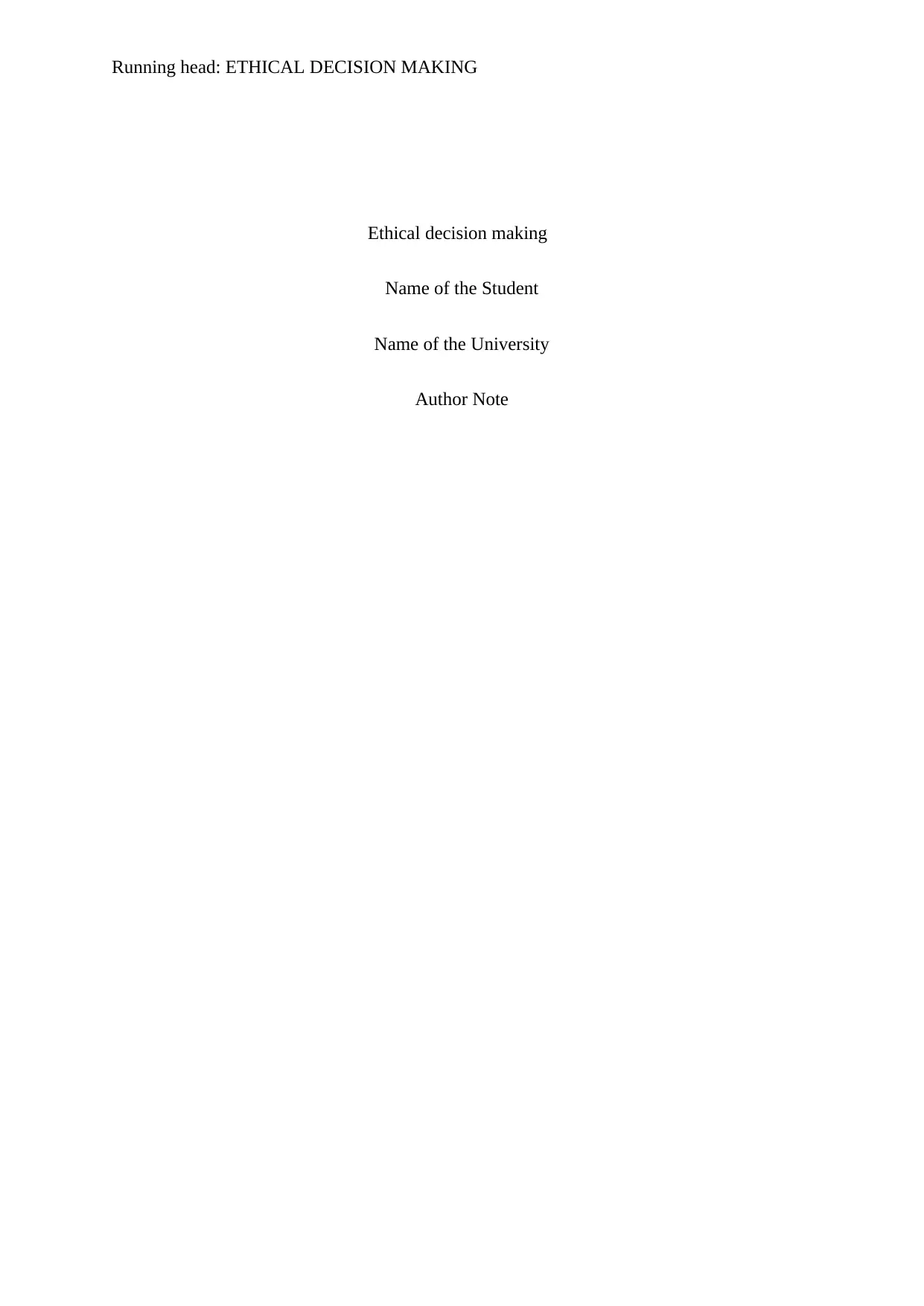
Running head: ETHICAL DECISION MAKING
Ethical decision making
Name of the Student
Name of the University
Author Note
Ethical decision making
Name of the Student
Name of the University
Author Note
Secure Best Marks with AI Grader
Need help grading? Try our AI Grader for instant feedback on your assignments.
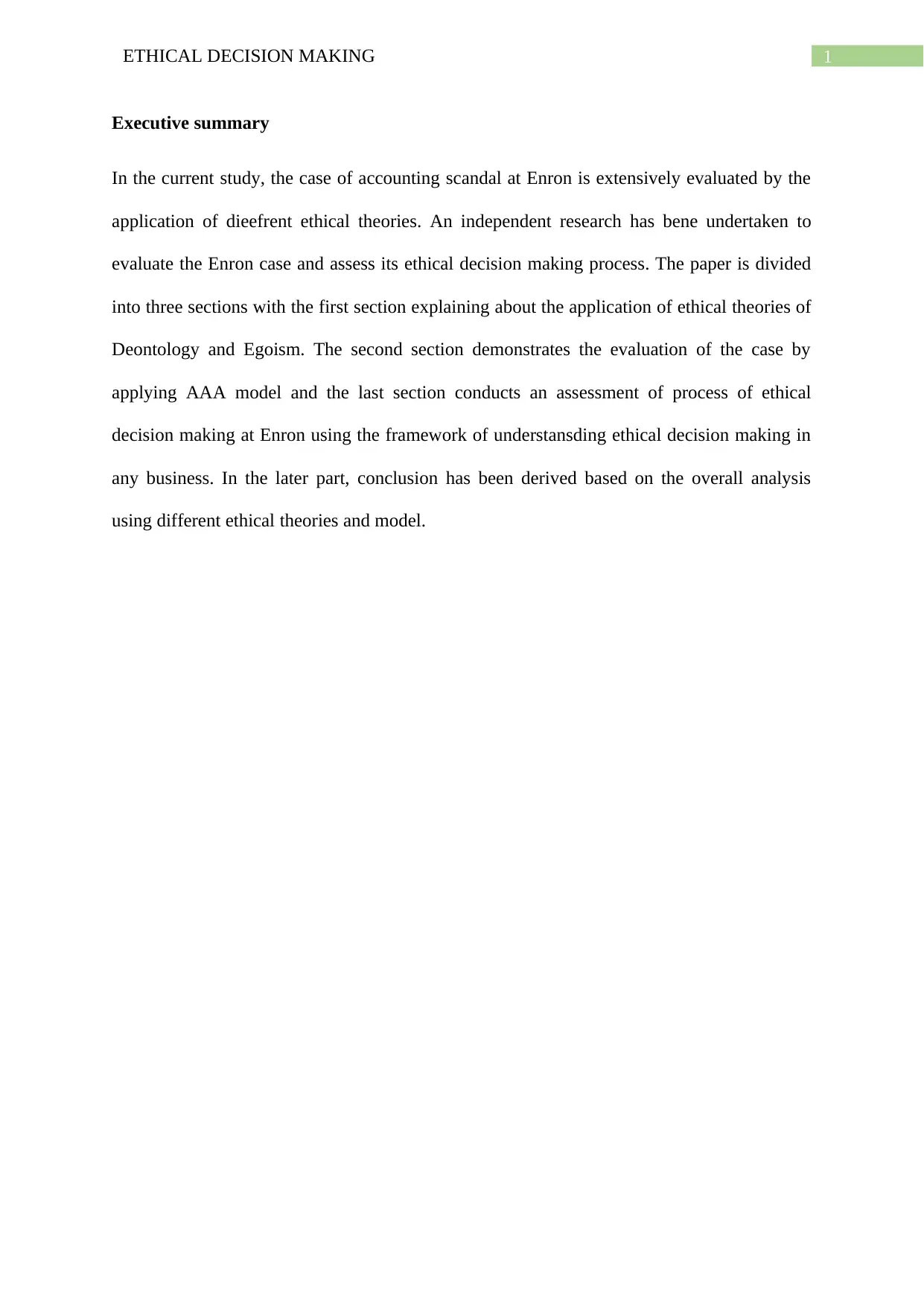
1ETHICAL DECISION MAKING
Executive summary
In the current study, the case of accounting scandal at Enron is extensively evaluated by the
application of dieefrent ethical theories. An independent research has bene undertaken to
evaluate the Enron case and assess its ethical decision making process. The paper is divided
into three sections with the first section explaining about the application of ethical theories of
Deontology and Egoism. The second section demonstrates the evaluation of the case by
applying AAA model and the last section conducts an assessment of process of ethical
decision making at Enron using the framework of understansding ethical decision making in
any business. In the later part, conclusion has been derived based on the overall analysis
using different ethical theories and model.
Executive summary
In the current study, the case of accounting scandal at Enron is extensively evaluated by the
application of dieefrent ethical theories. An independent research has bene undertaken to
evaluate the Enron case and assess its ethical decision making process. The paper is divided
into three sections with the first section explaining about the application of ethical theories of
Deontology and Egoism. The second section demonstrates the evaluation of the case by
applying AAA model and the last section conducts an assessment of process of ethical
decision making at Enron using the framework of understansding ethical decision making in
any business. In the later part, conclusion has been derived based on the overall analysis
using different ethical theories and model.
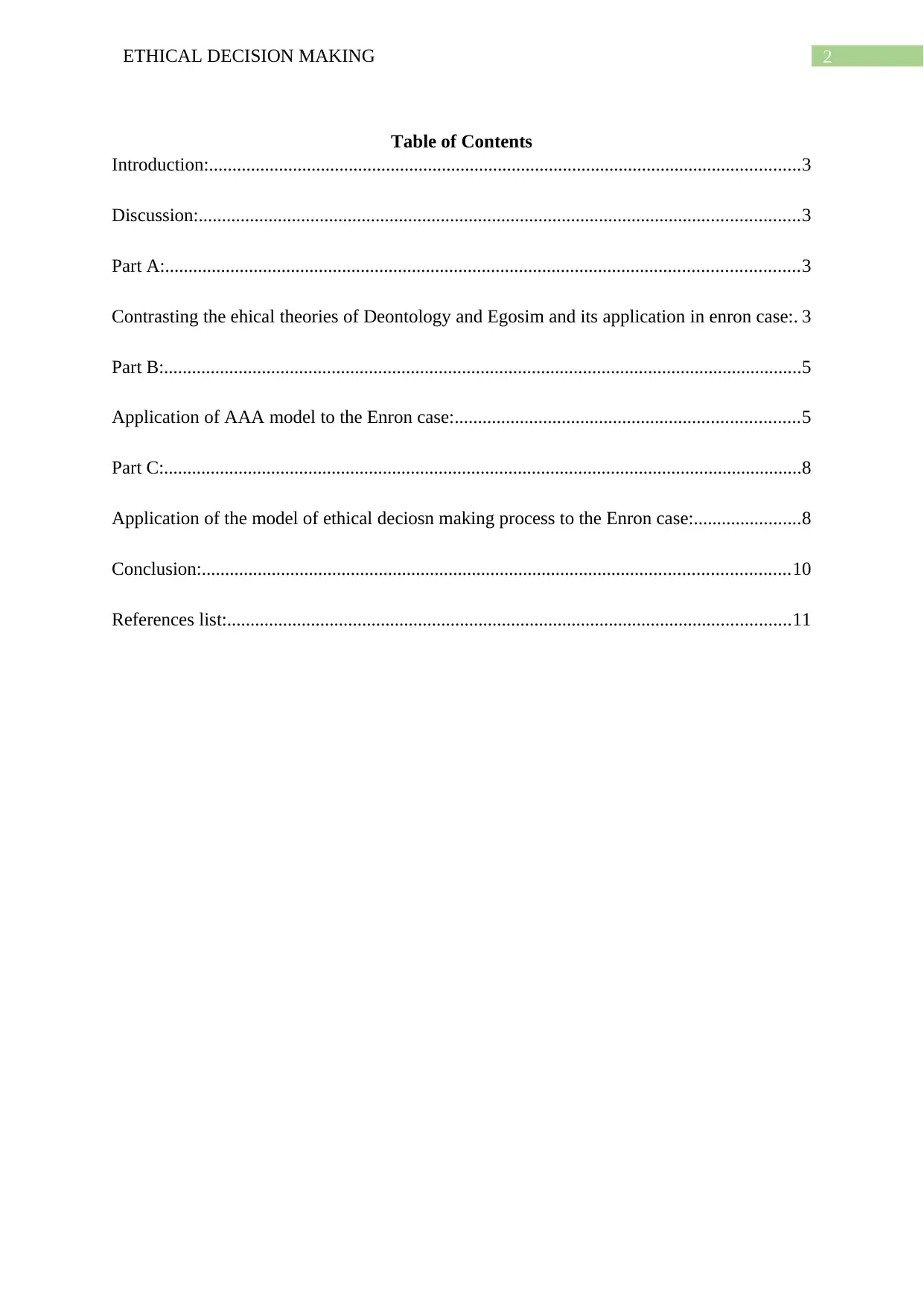
2ETHICAL DECISION MAKING
Table of Contents
Introduction:...............................................................................................................................3
Discussion:.................................................................................................................................3
Part A:........................................................................................................................................3
Contrasting the ehical theories of Deontology and Egosim and its application in enron case:. 3
Part B:.........................................................................................................................................5
Application of AAA model to the Enron case:..........................................................................5
Part C:.........................................................................................................................................8
Application of the model of ethical deciosn making process to the Enron case:.......................8
Conclusion:..............................................................................................................................10
References list:.........................................................................................................................11
Table of Contents
Introduction:...............................................................................................................................3
Discussion:.................................................................................................................................3
Part A:........................................................................................................................................3
Contrasting the ehical theories of Deontology and Egosim and its application in enron case:. 3
Part B:.........................................................................................................................................5
Application of AAA model to the Enron case:..........................................................................5
Part C:.........................................................................................................................................8
Application of the model of ethical deciosn making process to the Enron case:.......................8
Conclusion:..............................................................................................................................10
References list:.........................................................................................................................11
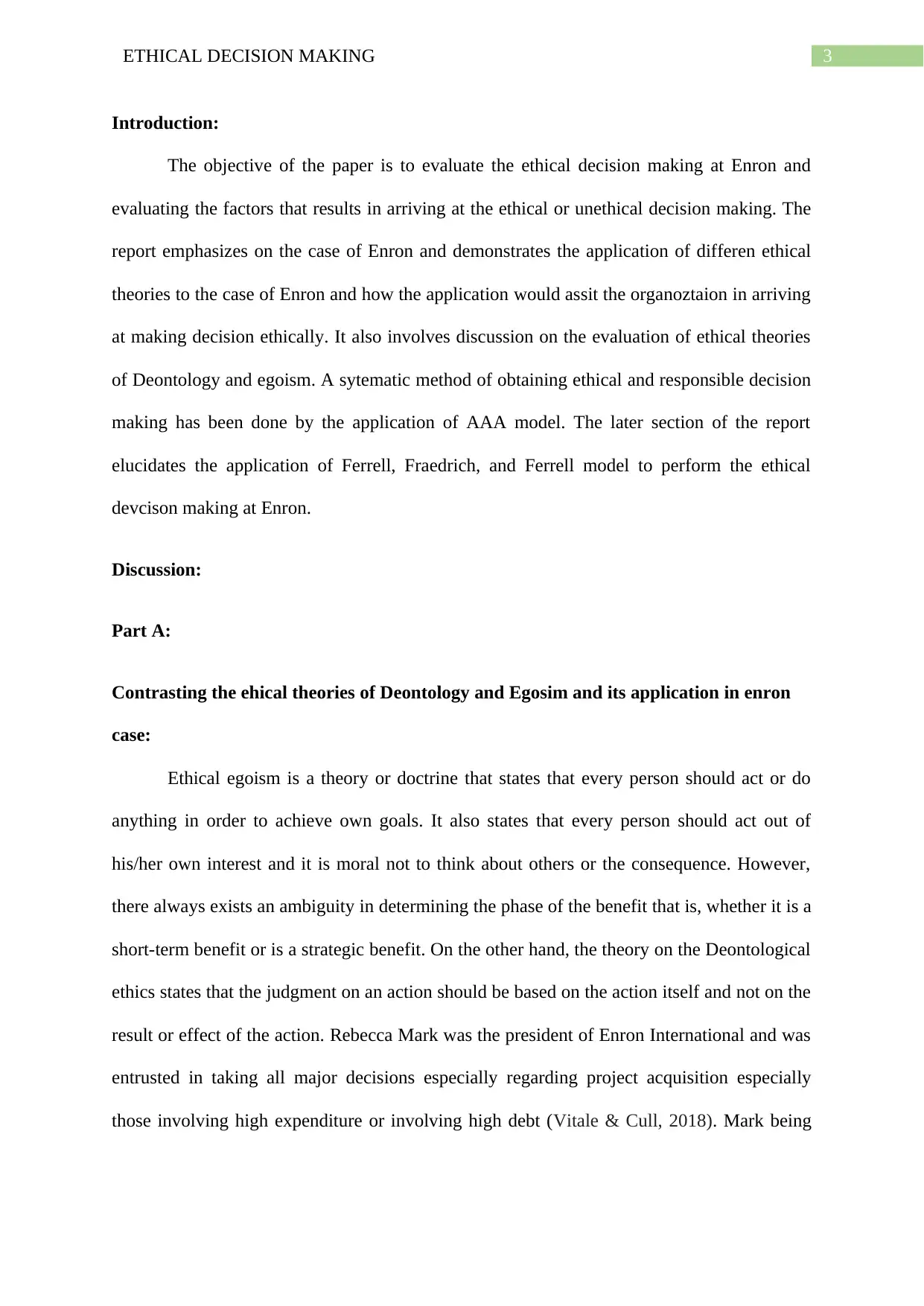
3ETHICAL DECISION MAKING
Introduction:
The objective of the paper is to evaluate the ethical decision making at Enron and
evaluating the factors that results in arriving at the ethical or unethical decision making. The
report emphasizes on the case of Enron and demonstrates the application of differen ethical
theories to the case of Enron and how the application would assit the organoztaion in arriving
at making decision ethically. It also involves discussion on the evaluation of ethical theories
of Deontology and egoism. A sytematic method of obtaining ethical and responsible decision
making has been done by the application of AAA model. The later section of the report
elucidates the application of Ferrell, Fraedrich, and Ferrell model to perform the ethical
devcison making at Enron.
Discussion:
Part A:
Contrasting the ehical theories of Deontology and Egosim and its application in enron
case:
Ethical egoism is a theory or doctrine that states that every person should act or do
anything in order to achieve own goals. It also states that every person should act out of
his/her own interest and it is moral not to think about others or the consequence. However,
there always exists an ambiguity in determining the phase of the benefit that is, whether it is a
short-term benefit or is a strategic benefit. On the other hand, the theory on the Deontological
ethics states that the judgment on an action should be based on the action itself and not on the
result or effect of the action. Rebecca Mark was the president of Enron International and was
entrusted in taking all major decisions especially regarding project acquisition especially
those involving high expenditure or involving high debt (Vitale & Cull, 2018). Mark being
Introduction:
The objective of the paper is to evaluate the ethical decision making at Enron and
evaluating the factors that results in arriving at the ethical or unethical decision making. The
report emphasizes on the case of Enron and demonstrates the application of differen ethical
theories to the case of Enron and how the application would assit the organoztaion in arriving
at making decision ethically. It also involves discussion on the evaluation of ethical theories
of Deontology and egoism. A sytematic method of obtaining ethical and responsible decision
making has been done by the application of AAA model. The later section of the report
elucidates the application of Ferrell, Fraedrich, and Ferrell model to perform the ethical
devcison making at Enron.
Discussion:
Part A:
Contrasting the ehical theories of Deontology and Egosim and its application in enron
case:
Ethical egoism is a theory or doctrine that states that every person should act or do
anything in order to achieve own goals. It also states that every person should act out of
his/her own interest and it is moral not to think about others or the consequence. However,
there always exists an ambiguity in determining the phase of the benefit that is, whether it is a
short-term benefit or is a strategic benefit. On the other hand, the theory on the Deontological
ethics states that the judgment on an action should be based on the action itself and not on the
result or effect of the action. Rebecca Mark was the president of Enron International and was
entrusted in taking all major decisions especially regarding project acquisition especially
those involving high expenditure or involving high debt (Vitale & Cull, 2018). Mark being
Secure Best Marks with AI Grader
Need help grading? Try our AI Grader for instant feedback on your assignments.
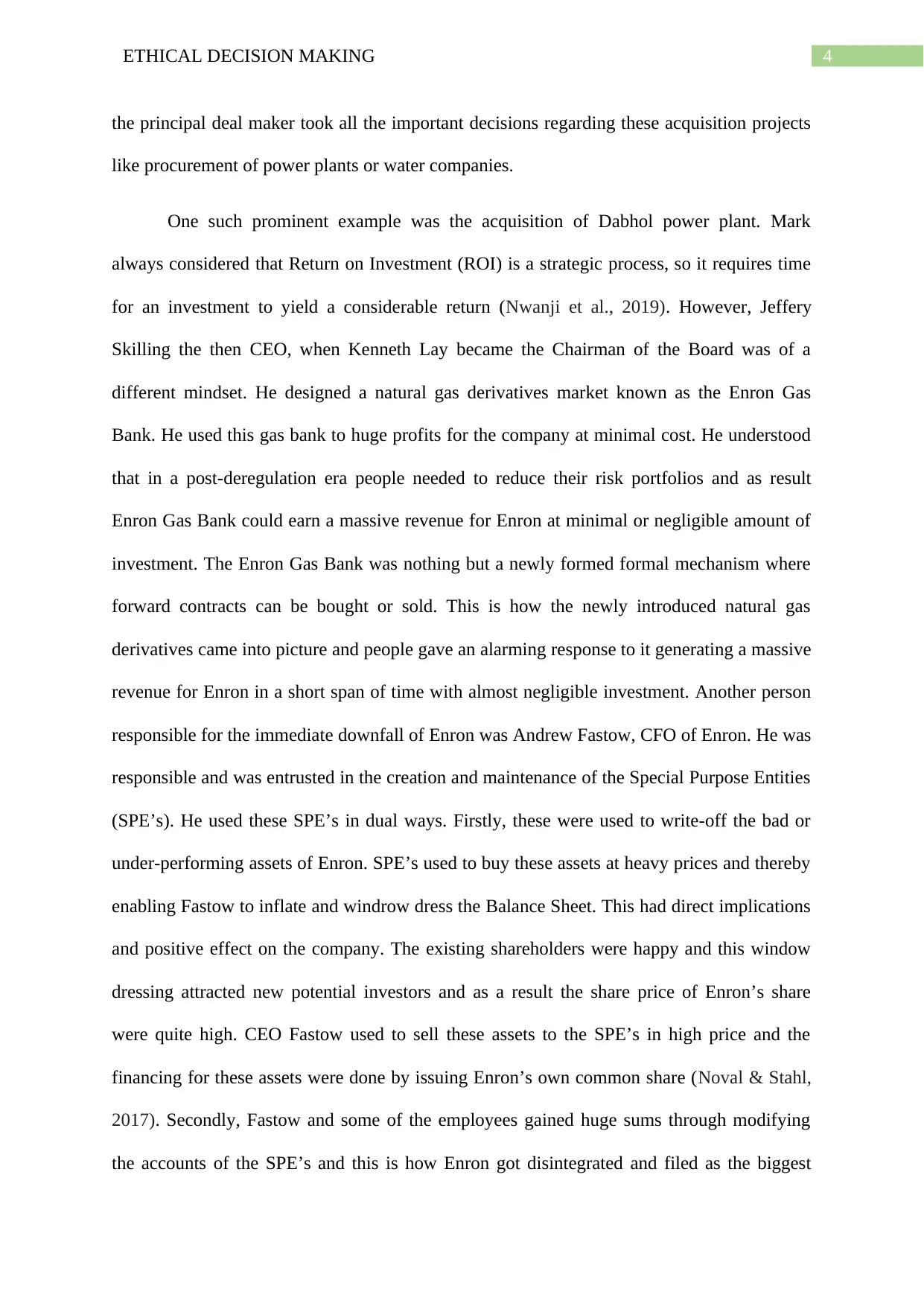
4ETHICAL DECISION MAKING
the principal deal maker took all the important decisions regarding these acquisition projects
like procurement of power plants or water companies.
One such prominent example was the acquisition of Dabhol power plant. Mark
always considered that Return on Investment (ROI) is a strategic process, so it requires time
for an investment to yield a considerable return (Nwanji et al., 2019). However, Jeffery
Skilling the then CEO, when Kenneth Lay became the Chairman of the Board was of a
different mindset. He designed a natural gas derivatives market known as the Enron Gas
Bank. He used this gas bank to huge profits for the company at minimal cost. He understood
that in a post-deregulation era people needed to reduce their risk portfolios and as result
Enron Gas Bank could earn a massive revenue for Enron at minimal or negligible amount of
investment. The Enron Gas Bank was nothing but a newly formed formal mechanism where
forward contracts can be bought or sold. This is how the newly introduced natural gas
derivatives came into picture and people gave an alarming response to it generating a massive
revenue for Enron in a short span of time with almost negligible investment. Another person
responsible for the immediate downfall of Enron was Andrew Fastow, CFO of Enron. He was
responsible and was entrusted in the creation and maintenance of the Special Purpose Entities
(SPE’s). He used these SPE’s in dual ways. Firstly, these were used to write-off the bad or
under-performing assets of Enron. SPE’s used to buy these assets at heavy prices and thereby
enabling Fastow to inflate and windrow dress the Balance Sheet. This had direct implications
and positive effect on the company. The existing shareholders were happy and this window
dressing attracted new potential investors and as a result the share price of Enron’s share
were quite high. CEO Fastow used to sell these assets to the SPE’s in high price and the
financing for these assets were done by issuing Enron’s own common share (Noval & Stahl,
2017). Secondly, Fastow and some of the employees gained huge sums through modifying
the accounts of the SPE’s and this is how Enron got disintegrated and filed as the biggest
the principal deal maker took all the important decisions regarding these acquisition projects
like procurement of power plants or water companies.
One such prominent example was the acquisition of Dabhol power plant. Mark
always considered that Return on Investment (ROI) is a strategic process, so it requires time
for an investment to yield a considerable return (Nwanji et al., 2019). However, Jeffery
Skilling the then CEO, when Kenneth Lay became the Chairman of the Board was of a
different mindset. He designed a natural gas derivatives market known as the Enron Gas
Bank. He used this gas bank to huge profits for the company at minimal cost. He understood
that in a post-deregulation era people needed to reduce their risk portfolios and as result
Enron Gas Bank could earn a massive revenue for Enron at minimal or negligible amount of
investment. The Enron Gas Bank was nothing but a newly formed formal mechanism where
forward contracts can be bought or sold. This is how the newly introduced natural gas
derivatives came into picture and people gave an alarming response to it generating a massive
revenue for Enron in a short span of time with almost negligible investment. Another person
responsible for the immediate downfall of Enron was Andrew Fastow, CFO of Enron. He was
responsible and was entrusted in the creation and maintenance of the Special Purpose Entities
(SPE’s). He used these SPE’s in dual ways. Firstly, these were used to write-off the bad or
under-performing assets of Enron. SPE’s used to buy these assets at heavy prices and thereby
enabling Fastow to inflate and windrow dress the Balance Sheet. This had direct implications
and positive effect on the company. The existing shareholders were happy and this window
dressing attracted new potential investors and as a result the share price of Enron’s share
were quite high. CEO Fastow used to sell these assets to the SPE’s in high price and the
financing for these assets were done by issuing Enron’s own common share (Noval & Stahl,
2017). Secondly, Fastow and some of the employees gained huge sums through modifying
the accounts of the SPE’s and this is how Enron got disintegrated and filed as the biggest
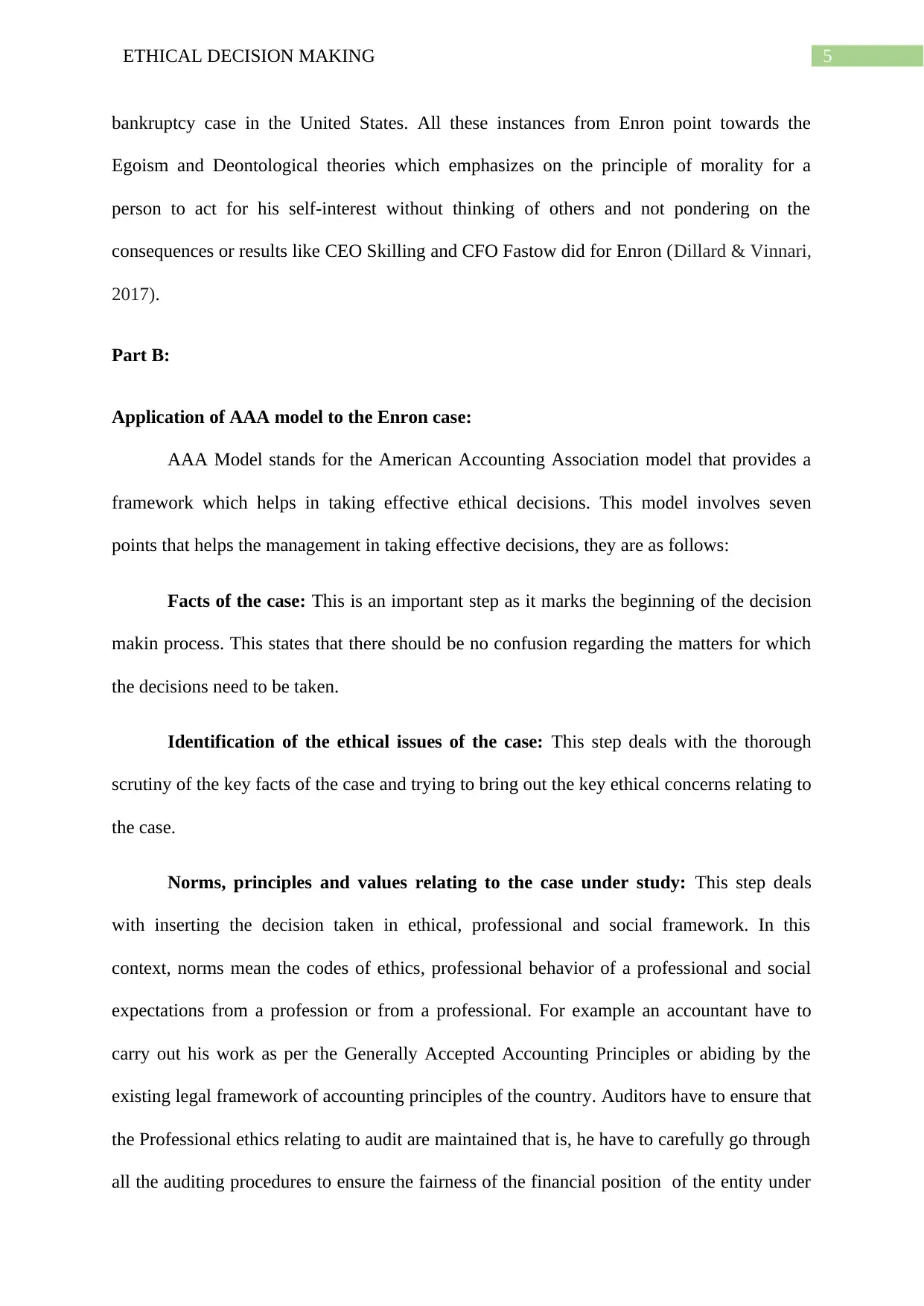
5ETHICAL DECISION MAKING
bankruptcy case in the United States. All these instances from Enron point towards the
Egoism and Deontological theories which emphasizes on the principle of morality for a
person to act for his self-interest without thinking of others and not pondering on the
consequences or results like CEO Skilling and CFO Fastow did for Enron (Dillard & Vinnari,
2017).
Part B:
Application of AAA model to the Enron case:
AAA Model stands for the American Accounting Association model that provides a
framework which helps in taking effective ethical decisions. This model involves seven
points that helps the management in taking effective decisions, they are as follows:
Facts of the case: This is an important step as it marks the beginning of the decision
makin process. This states that there should be no confusion regarding the matters for which
the decisions need to be taken.
Identification of the ethical issues of the case: This step deals with the thorough
scrutiny of the key facts of the case and trying to bring out the key ethical concerns relating to
the case.
Norms, principles and values relating to the case under study: This step deals
with inserting the decision taken in ethical, professional and social framework. In this
context, norms mean the codes of ethics, professional behavior of a professional and social
expectations from a profession or from a professional. For example an accountant have to
carry out his work as per the Generally Accepted Accounting Principles or abiding by the
existing legal framework of accounting principles of the country. Auditors have to ensure that
the Professional ethics relating to audit are maintained that is, he have to carefully go through
all the auditing procedures to ensure the fairness of the financial position of the entity under
bankruptcy case in the United States. All these instances from Enron point towards the
Egoism and Deontological theories which emphasizes on the principle of morality for a
person to act for his self-interest without thinking of others and not pondering on the
consequences or results like CEO Skilling and CFO Fastow did for Enron (Dillard & Vinnari,
2017).
Part B:
Application of AAA model to the Enron case:
AAA Model stands for the American Accounting Association model that provides a
framework which helps in taking effective ethical decisions. This model involves seven
points that helps the management in taking effective decisions, they are as follows:
Facts of the case: This is an important step as it marks the beginning of the decision
makin process. This states that there should be no confusion regarding the matters for which
the decisions need to be taken.
Identification of the ethical issues of the case: This step deals with the thorough
scrutiny of the key facts of the case and trying to bring out the key ethical concerns relating to
the case.
Norms, principles and values relating to the case under study: This step deals
with inserting the decision taken in ethical, professional and social framework. In this
context, norms mean the codes of ethics, professional behavior of a professional and social
expectations from a profession or from a professional. For example an accountant have to
carry out his work as per the Generally Accepted Accounting Principles or abiding by the
existing legal framework of accounting principles of the country. Auditors have to ensure that
the Professional ethics relating to audit are maintained that is, he have to carefully go through
all the auditing procedures to ensure the fairness of the financial position of the entity under
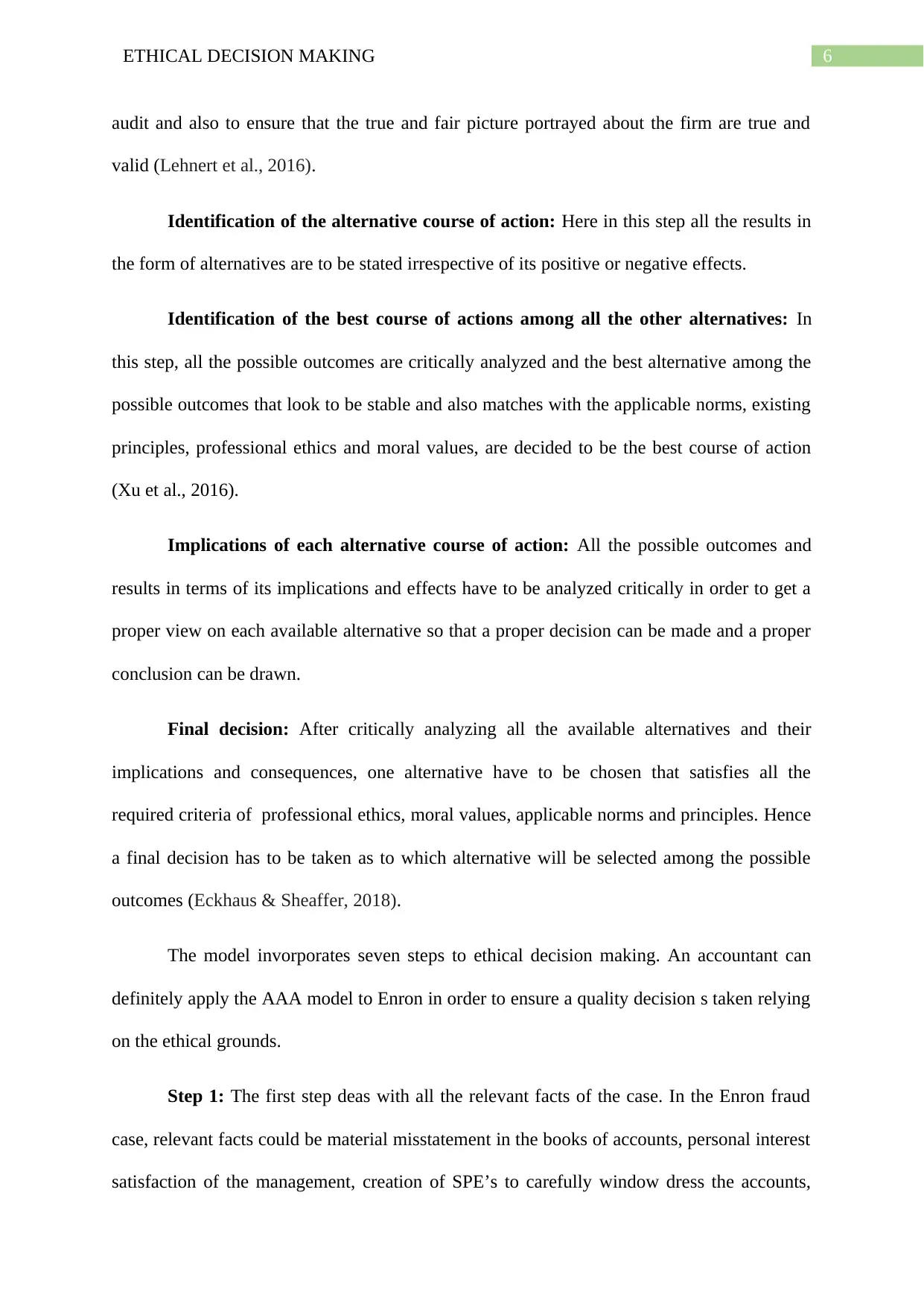
6ETHICAL DECISION MAKING
audit and also to ensure that the true and fair picture portrayed about the firm are true and
valid (Lehnert et al., 2016).
Identification of the alternative course of action: Here in this step all the results in
the form of alternatives are to be stated irrespective of its positive or negative effects.
Identification of the best course of actions among all the other alternatives: In
this step, all the possible outcomes are critically analyzed and the best alternative among the
possible outcomes that look to be stable and also matches with the applicable norms, existing
principles, professional ethics and moral values, are decided to be the best course of action
(Xu et al., 2016).
Implications of each alternative course of action: All the possible outcomes and
results in terms of its implications and effects have to be analyzed critically in order to get a
proper view on each available alternative so that a proper decision can be made and a proper
conclusion can be drawn.
Final decision: After critically analyzing all the available alternatives and their
implications and consequences, one alternative have to be chosen that satisfies all the
required criteria of professional ethics, moral values, applicable norms and principles. Hence
a final decision has to be taken as to which alternative will be selected among the possible
outcomes (Eckhaus & Sheaffer, 2018).
The model invorporates seven steps to ethical decision making. An accountant can
definitely apply the AAA model to Enron in order to ensure a quality decision s taken relying
on the ethical grounds.
Step 1: The first step deas with all the relevant facts of the case. In the Enron fraud
case, relevant facts could be material misstatement in the books of accounts, personal interest
satisfaction of the management, creation of SPE’s to carefully window dress the accounts,
audit and also to ensure that the true and fair picture portrayed about the firm are true and
valid (Lehnert et al., 2016).
Identification of the alternative course of action: Here in this step all the results in
the form of alternatives are to be stated irrespective of its positive or negative effects.
Identification of the best course of actions among all the other alternatives: In
this step, all the possible outcomes are critically analyzed and the best alternative among the
possible outcomes that look to be stable and also matches with the applicable norms, existing
principles, professional ethics and moral values, are decided to be the best course of action
(Xu et al., 2016).
Implications of each alternative course of action: All the possible outcomes and
results in terms of its implications and effects have to be analyzed critically in order to get a
proper view on each available alternative so that a proper decision can be made and a proper
conclusion can be drawn.
Final decision: After critically analyzing all the available alternatives and their
implications and consequences, one alternative have to be chosen that satisfies all the
required criteria of professional ethics, moral values, applicable norms and principles. Hence
a final decision has to be taken as to which alternative will be selected among the possible
outcomes (Eckhaus & Sheaffer, 2018).
The model invorporates seven steps to ethical decision making. An accountant can
definitely apply the AAA model to Enron in order to ensure a quality decision s taken relying
on the ethical grounds.
Step 1: The first step deas with all the relevant facts of the case. In the Enron fraud
case, relevant facts could be material misstatement in the books of accounts, personal interest
satisfaction of the management, creation of SPE’s to carefully window dress the accounts,
Paraphrase This Document
Need a fresh take? Get an instant paraphrase of this document with our AI Paraphraser
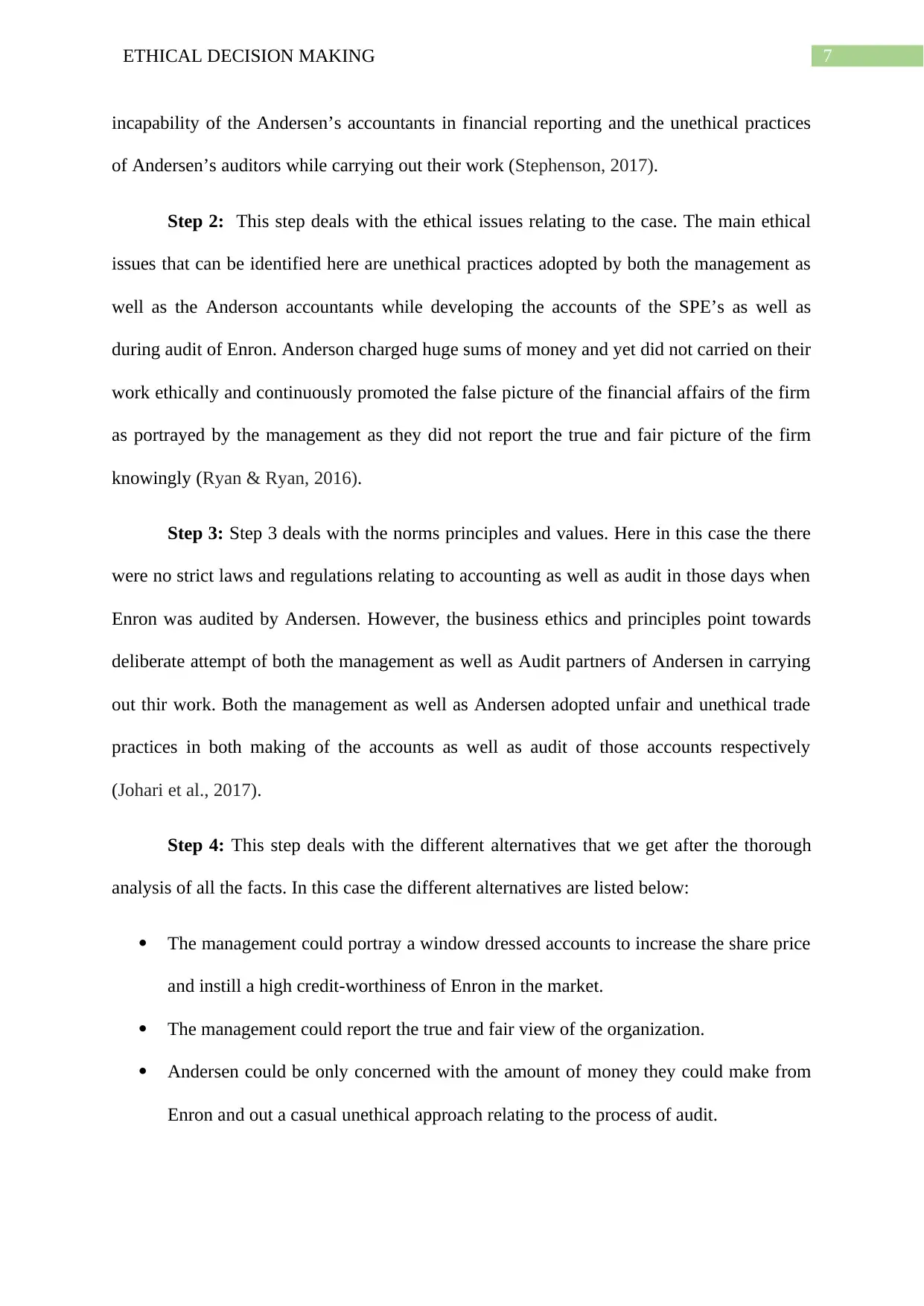
7ETHICAL DECISION MAKING
incapability of the Andersen’s accountants in financial reporting and the unethical practices
of Andersen’s auditors while carrying out their work (Stephenson, 2017).
Step 2: This step deals with the ethical issues relating to the case. The main ethical
issues that can be identified here are unethical practices adopted by both the management as
well as the Anderson accountants while developing the accounts of the SPE’s as well as
during audit of Enron. Anderson charged huge sums of money and yet did not carried on their
work ethically and continuously promoted the false picture of the financial affairs of the firm
as portrayed by the management as they did not report the true and fair picture of the firm
knowingly (Ryan & Ryan, 2016).
Step 3: Step 3 deals with the norms principles and values. Here in this case the there
were no strict laws and regulations relating to accounting as well as audit in those days when
Enron was audited by Andersen. However, the business ethics and principles point towards
deliberate attempt of both the management as well as Audit partners of Andersen in carrying
out thir work. Both the management as well as Andersen adopted unfair and unethical trade
practices in both making of the accounts as well as audit of those accounts respectively
(Johari et al., 2017).
Step 4: This step deals with the different alternatives that we get after the thorough
analysis of all the facts. In this case the different alternatives are listed below:
The management could portray a window dressed accounts to increase the share price
and instill a high credit-worthiness of Enron in the market.
The management could report the true and fair view of the organization.
Andersen could be only concerned with the amount of money they could make from
Enron and out a casual unethical approach relating to the process of audit.
incapability of the Andersen’s accountants in financial reporting and the unethical practices
of Andersen’s auditors while carrying out their work (Stephenson, 2017).
Step 2: This step deals with the ethical issues relating to the case. The main ethical
issues that can be identified here are unethical practices adopted by both the management as
well as the Anderson accountants while developing the accounts of the SPE’s as well as
during audit of Enron. Anderson charged huge sums of money and yet did not carried on their
work ethically and continuously promoted the false picture of the financial affairs of the firm
as portrayed by the management as they did not report the true and fair picture of the firm
knowingly (Ryan & Ryan, 2016).
Step 3: Step 3 deals with the norms principles and values. Here in this case the there
were no strict laws and regulations relating to accounting as well as audit in those days when
Enron was audited by Andersen. However, the business ethics and principles point towards
deliberate attempt of both the management as well as Audit partners of Andersen in carrying
out thir work. Both the management as well as Andersen adopted unfair and unethical trade
practices in both making of the accounts as well as audit of those accounts respectively
(Johari et al., 2017).
Step 4: This step deals with the different alternatives that we get after the thorough
analysis of all the facts. In this case the different alternatives are listed below:
The management could portray a window dressed accounts to increase the share price
and instill a high credit-worthiness of Enron in the market.
The management could report the true and fair view of the organization.
Andersen could be only concerned with the amount of money they could make from
Enron and out a casual unethical approach relating to the process of audit.
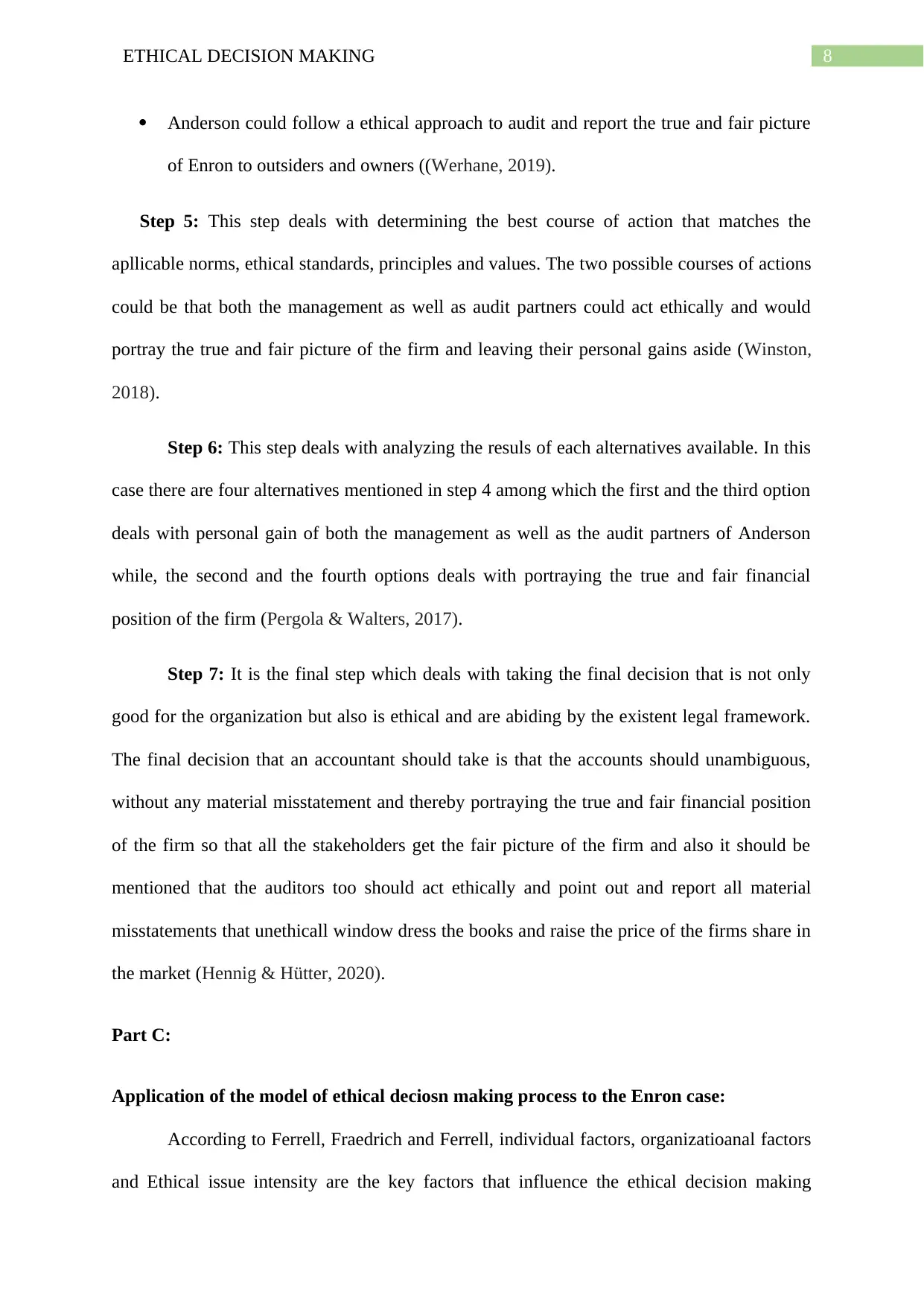
8ETHICAL DECISION MAKING
Anderson could follow a ethical approach to audit and report the true and fair picture
of Enron to outsiders and owners ((Werhane, 2019).
Step 5: This step deals with determining the best course of action that matches the
apllicable norms, ethical standards, principles and values. The two possible courses of actions
could be that both the management as well as audit partners could act ethically and would
portray the true and fair picture of the firm and leaving their personal gains aside (Winston,
2018).
Step 6: This step deals with analyzing the resuls of each alternatives available. In this
case there are four alternatives mentioned in step 4 among which the first and the third option
deals with personal gain of both the management as well as the audit partners of Anderson
while, the second and the fourth options deals with portraying the true and fair financial
position of the firm (Pergola & Walters, 2017).
Step 7: It is the final step which deals with taking the final decision that is not only
good for the organization but also is ethical and are abiding by the existent legal framework.
The final decision that an accountant should take is that the accounts should unambiguous,
without any material misstatement and thereby portraying the true and fair financial position
of the firm so that all the stakeholders get the fair picture of the firm and also it should be
mentioned that the auditors too should act ethically and point out and report all material
misstatements that unethicall window dress the books and raise the price of the firms share in
the market (Hennig & Hütter, 2020).
Part C:
Application of the model of ethical deciosn making process to the Enron case:
According to Ferrell, Fraedrich and Ferrell, individual factors, organizatioanal factors
and Ethical issue intensity are the key factors that influence the ethical decision making
Anderson could follow a ethical approach to audit and report the true and fair picture
of Enron to outsiders and owners ((Werhane, 2019).
Step 5: This step deals with determining the best course of action that matches the
apllicable norms, ethical standards, principles and values. The two possible courses of actions
could be that both the management as well as audit partners could act ethically and would
portray the true and fair picture of the firm and leaving their personal gains aside (Winston,
2018).
Step 6: This step deals with analyzing the resuls of each alternatives available. In this
case there are four alternatives mentioned in step 4 among which the first and the third option
deals with personal gain of both the management as well as the audit partners of Anderson
while, the second and the fourth options deals with portraying the true and fair financial
position of the firm (Pergola & Walters, 2017).
Step 7: It is the final step which deals with taking the final decision that is not only
good for the organization but also is ethical and are abiding by the existent legal framework.
The final decision that an accountant should take is that the accounts should unambiguous,
without any material misstatement and thereby portraying the true and fair financial position
of the firm so that all the stakeholders get the fair picture of the firm and also it should be
mentioned that the auditors too should act ethically and point out and report all material
misstatements that unethicall window dress the books and raise the price of the firms share in
the market (Hennig & Hütter, 2020).
Part C:
Application of the model of ethical deciosn making process to the Enron case:
According to Ferrell, Fraedrich and Ferrell, individual factors, organizatioanal factors
and Ethical issue intensity are the key factors that influence the ethical decision making
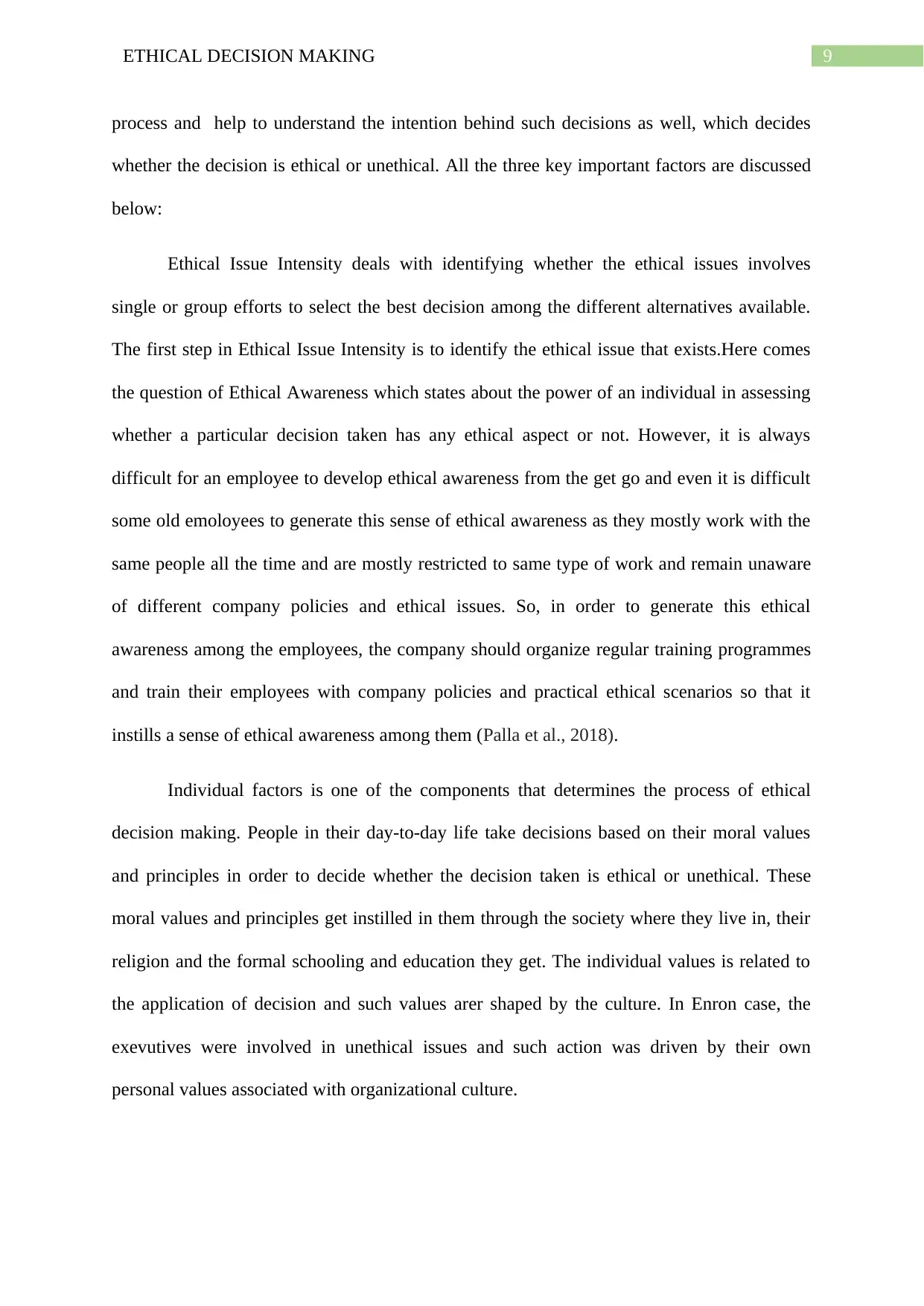
9ETHICAL DECISION MAKING
process and help to understand the intention behind such decisions as well, which decides
whether the decision is ethical or unethical. All the three key important factors are discussed
below:
Ethical Issue Intensity deals with identifying whether the ethical issues involves
single or group efforts to select the best decision among the different alternatives available.
The first step in Ethical Issue Intensity is to identify the ethical issue that exists.Here comes
the question of Ethical Awareness which states about the power of an individual in assessing
whether a particular decision taken has any ethical aspect or not. However, it is always
difficult for an employee to develop ethical awareness from the get go and even it is difficult
some old emoloyees to generate this sense of ethical awareness as they mostly work with the
same people all the time and are mostly restricted to same type of work and remain unaware
of different company policies and ethical issues. So, in order to generate this ethical
awareness among the employees, the company should organize regular training programmes
and train their employees with company policies and practical ethical scenarios so that it
instills a sense of ethical awareness among them (Palla et al., 2018).
Individual factors is one of the components that determines the process of ethical
decision making. People in their day-to-day life take decisions based on their moral values
and principles in order to decide whether the decision taken is ethical or unethical. These
moral values and principles get instilled in them through the society where they live in, their
religion and the formal schooling and education they get. The individual values is related to
the application of decision and such values arer shaped by the culture. In Enron case, the
exevutives were involved in unethical issues and such action was driven by their own
personal values associated with organizational culture.
process and help to understand the intention behind such decisions as well, which decides
whether the decision is ethical or unethical. All the three key important factors are discussed
below:
Ethical Issue Intensity deals with identifying whether the ethical issues involves
single or group efforts to select the best decision among the different alternatives available.
The first step in Ethical Issue Intensity is to identify the ethical issue that exists.Here comes
the question of Ethical Awareness which states about the power of an individual in assessing
whether a particular decision taken has any ethical aspect or not. However, it is always
difficult for an employee to develop ethical awareness from the get go and even it is difficult
some old emoloyees to generate this sense of ethical awareness as they mostly work with the
same people all the time and are mostly restricted to same type of work and remain unaware
of different company policies and ethical issues. So, in order to generate this ethical
awareness among the employees, the company should organize regular training programmes
and train their employees with company policies and practical ethical scenarios so that it
instills a sense of ethical awareness among them (Palla et al., 2018).
Individual factors is one of the components that determines the process of ethical
decision making. People in their day-to-day life take decisions based on their moral values
and principles in order to decide whether the decision taken is ethical or unethical. These
moral values and principles get instilled in them through the society where they live in, their
religion and the formal schooling and education they get. The individual values is related to
the application of decision and such values arer shaped by the culture. In Enron case, the
exevutives were involved in unethical issues and such action was driven by their own
personal values associated with organizational culture.
Secure Best Marks with AI Grader
Need help grading? Try our AI Grader for instant feedback on your assignments.
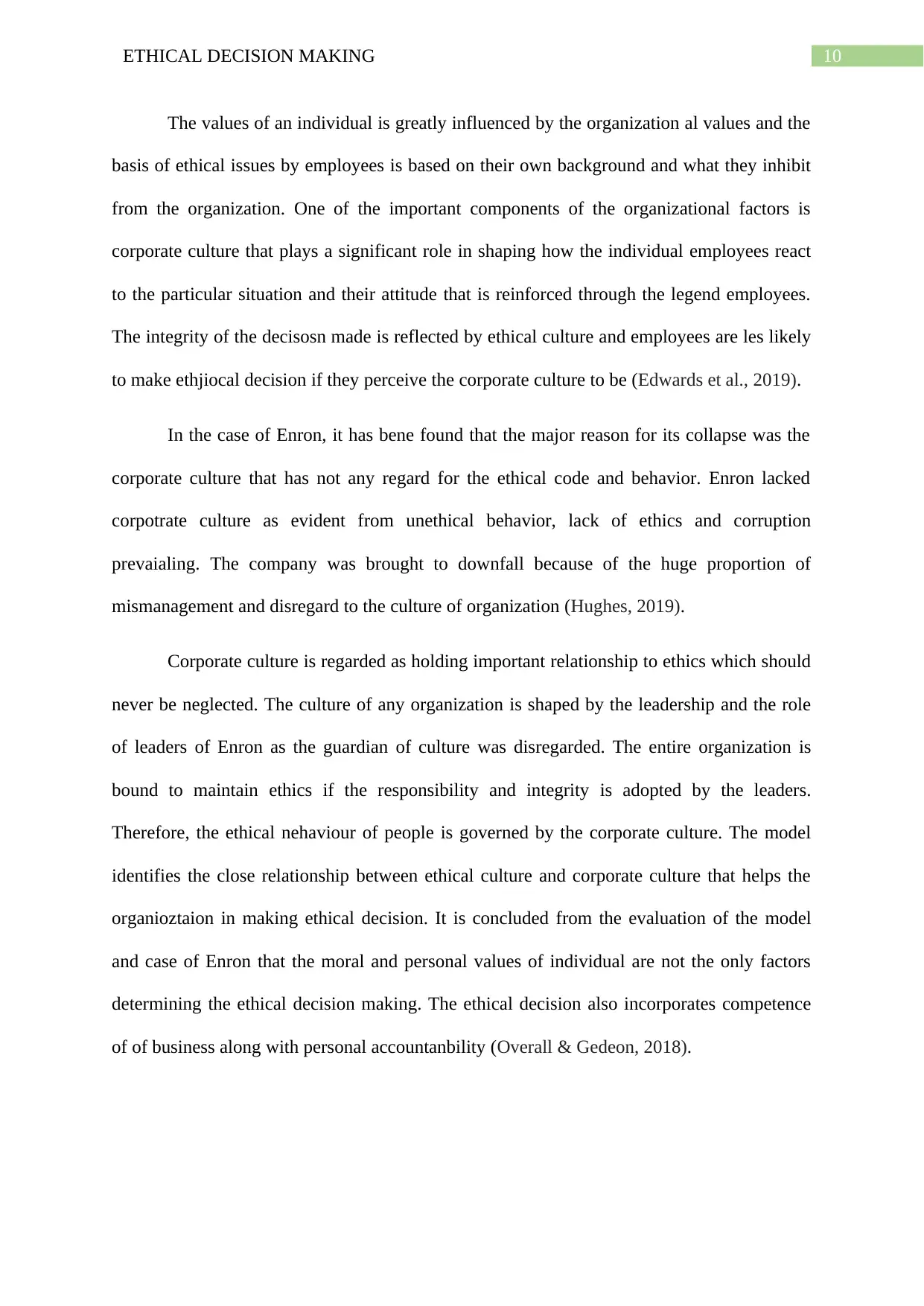
10ETHICAL DECISION MAKING
The values of an individual is greatly influenced by the organization al values and the
basis of ethical issues by employees is based on their own background and what they inhibit
from the organization. One of the important components of the organizational factors is
corporate culture that plays a significant role in shaping how the individual employees react
to the particular situation and their attitude that is reinforced through the legend employees.
The integrity of the decisosn made is reflected by ethical culture and employees are les likely
to make ethjiocal decision if they perceive the corporate culture to be (Edwards et al., 2019).
In the case of Enron, it has bene found that the major reason for its collapse was the
corporate culture that has not any regard for the ethical code and behavior. Enron lacked
corpotrate culture as evident from unethical behavior, lack of ethics and corruption
prevaialing. The company was brought to downfall because of the huge proportion of
mismanagement and disregard to the culture of organization (Hughes, 2019).
Corporate culture is regarded as holding important relationship to ethics which should
never be neglected. The culture of any organization is shaped by the leadership and the role
of leaders of Enron as the guardian of culture was disregarded. The entire organization is
bound to maintain ethics if the responsibility and integrity is adopted by the leaders.
Therefore, the ethical nehaviour of people is governed by the corporate culture. The model
identifies the close relationship between ethical culture and corporate culture that helps the
organioztaion in making ethical decision. It is concluded from the evaluation of the model
and case of Enron that the moral and personal values of individual are not the only factors
determining the ethical decision making. The ethical decision also incorporates competence
of of business along with personal accountanbility (Overall & Gedeon, 2018).
The values of an individual is greatly influenced by the organization al values and the
basis of ethical issues by employees is based on their own background and what they inhibit
from the organization. One of the important components of the organizational factors is
corporate culture that plays a significant role in shaping how the individual employees react
to the particular situation and their attitude that is reinforced through the legend employees.
The integrity of the decisosn made is reflected by ethical culture and employees are les likely
to make ethjiocal decision if they perceive the corporate culture to be (Edwards et al., 2019).
In the case of Enron, it has bene found that the major reason for its collapse was the
corporate culture that has not any regard for the ethical code and behavior. Enron lacked
corpotrate culture as evident from unethical behavior, lack of ethics and corruption
prevaialing. The company was brought to downfall because of the huge proportion of
mismanagement and disregard to the culture of organization (Hughes, 2019).
Corporate culture is regarded as holding important relationship to ethics which should
never be neglected. The culture of any organization is shaped by the leadership and the role
of leaders of Enron as the guardian of culture was disregarded. The entire organization is
bound to maintain ethics if the responsibility and integrity is adopted by the leaders.
Therefore, the ethical nehaviour of people is governed by the corporate culture. The model
identifies the close relationship between ethical culture and corporate culture that helps the
organioztaion in making ethical decision. It is concluded from the evaluation of the model
and case of Enron that the moral and personal values of individual are not the only factors
determining the ethical decision making. The ethical decision also incorporates competence
of of business along with personal accountanbility (Overall & Gedeon, 2018).
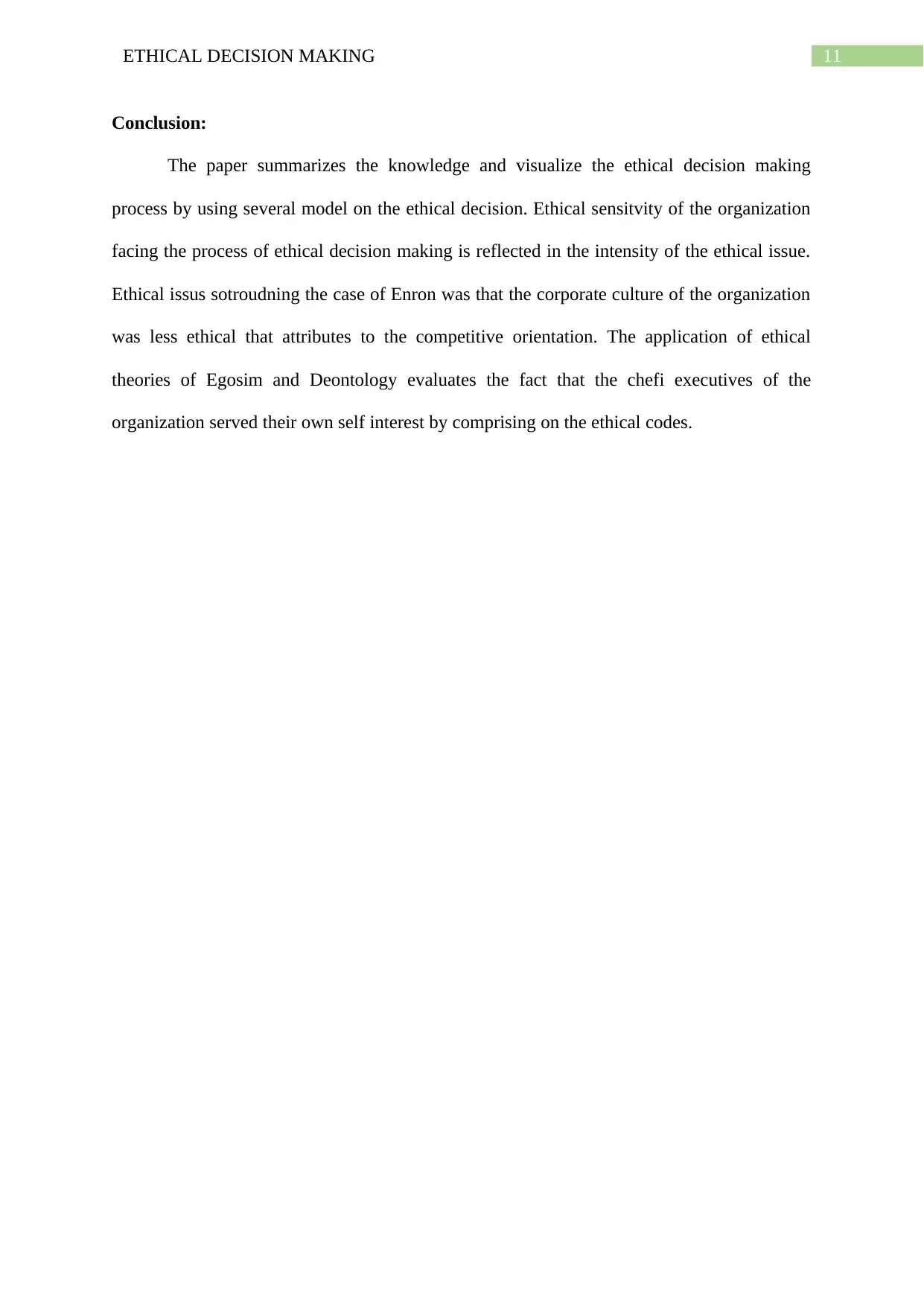
11ETHICAL DECISION MAKING
Conclusion:
The paper summarizes the knowledge and visualize the ethical decision making
process by using several model on the ethical decision. Ethical sensitvity of the organization
facing the process of ethical decision making is reflected in the intensity of the ethical issue.
Ethical issus sotroudning the case of Enron was that the corporate culture of the organization
was less ethical that attributes to the competitive orientation. The application of ethical
theories of Egosim and Deontology evaluates the fact that the chefi executives of the
organization served their own self interest by comprising on the ethical codes.
Conclusion:
The paper summarizes the knowledge and visualize the ethical decision making
process by using several model on the ethical decision. Ethical sensitvity of the organization
facing the process of ethical decision making is reflected in the intensity of the ethical issue.
Ethical issus sotroudning the case of Enron was that the corporate culture of the organization
was less ethical that attributes to the competitive orientation. The application of ethical
theories of Egosim and Deontology evaluates the fact that the chefi executives of the
organization served their own self interest by comprising on the ethical codes.
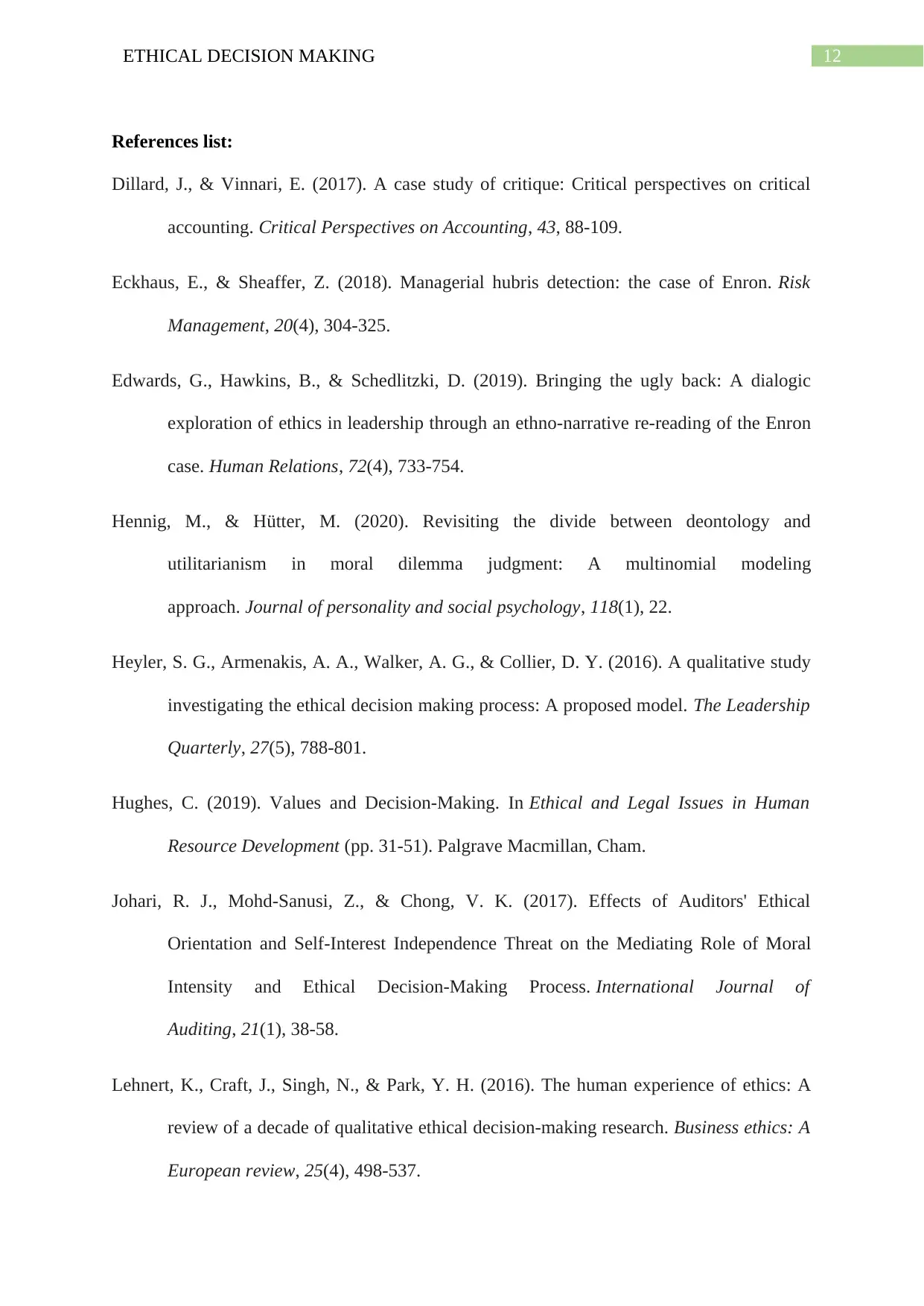
12ETHICAL DECISION MAKING
References list:
Dillard, J., & Vinnari, E. (2017). A case study of critique: Critical perspectives on critical
accounting. Critical Perspectives on Accounting, 43, 88-109.
Eckhaus, E., & Sheaffer, Z. (2018). Managerial hubris detection: the case of Enron. Risk
Management, 20(4), 304-325.
Edwards, G., Hawkins, B., & Schedlitzki, D. (2019). Bringing the ugly back: A dialogic
exploration of ethics in leadership through an ethno-narrative re-reading of the Enron
case. Human Relations, 72(4), 733-754.
Hennig, M., & Hütter, M. (2020). Revisiting the divide between deontology and
utilitarianism in moral dilemma judgment: A multinomial modeling
approach. Journal of personality and social psychology, 118(1), 22.
Heyler, S. G., Armenakis, A. A., Walker, A. G., & Collier, D. Y. (2016). A qualitative study
investigating the ethical decision making process: A proposed model. The Leadership
Quarterly, 27(5), 788-801.
Hughes, C. (2019). Values and Decision-Making. In Ethical and Legal Issues in Human
Resource Development (pp. 31-51). Palgrave Macmillan, Cham.
Johari, R. J., Mohd‐Sanusi, Z., & Chong, V. K. (2017). Effects of Auditors' Ethical
Orientation and Self‐Interest Independence Threat on the Mediating Role of Moral
Intensity and Ethical Decision‐Making Process. International Journal of
Auditing, 21(1), 38-58.
Lehnert, K., Craft, J., Singh, N., & Park, Y. H. (2016). The human experience of ethics: A
review of a decade of qualitative ethical decision‐making research. Business ethics: A
European review, 25(4), 498-537.
References list:
Dillard, J., & Vinnari, E. (2017). A case study of critique: Critical perspectives on critical
accounting. Critical Perspectives on Accounting, 43, 88-109.
Eckhaus, E., & Sheaffer, Z. (2018). Managerial hubris detection: the case of Enron. Risk
Management, 20(4), 304-325.
Edwards, G., Hawkins, B., & Schedlitzki, D. (2019). Bringing the ugly back: A dialogic
exploration of ethics in leadership through an ethno-narrative re-reading of the Enron
case. Human Relations, 72(4), 733-754.
Hennig, M., & Hütter, M. (2020). Revisiting the divide between deontology and
utilitarianism in moral dilemma judgment: A multinomial modeling
approach. Journal of personality and social psychology, 118(1), 22.
Heyler, S. G., Armenakis, A. A., Walker, A. G., & Collier, D. Y. (2016). A qualitative study
investigating the ethical decision making process: A proposed model. The Leadership
Quarterly, 27(5), 788-801.
Hughes, C. (2019). Values and Decision-Making. In Ethical and Legal Issues in Human
Resource Development (pp. 31-51). Palgrave Macmillan, Cham.
Johari, R. J., Mohd‐Sanusi, Z., & Chong, V. K. (2017). Effects of Auditors' Ethical
Orientation and Self‐Interest Independence Threat on the Mediating Role of Moral
Intensity and Ethical Decision‐Making Process. International Journal of
Auditing, 21(1), 38-58.
Lehnert, K., Craft, J., Singh, N., & Park, Y. H. (2016). The human experience of ethics: A
review of a decade of qualitative ethical decision‐making research. Business ethics: A
European review, 25(4), 498-537.
Paraphrase This Document
Need a fresh take? Get an instant paraphrase of this document with our AI Paraphraser
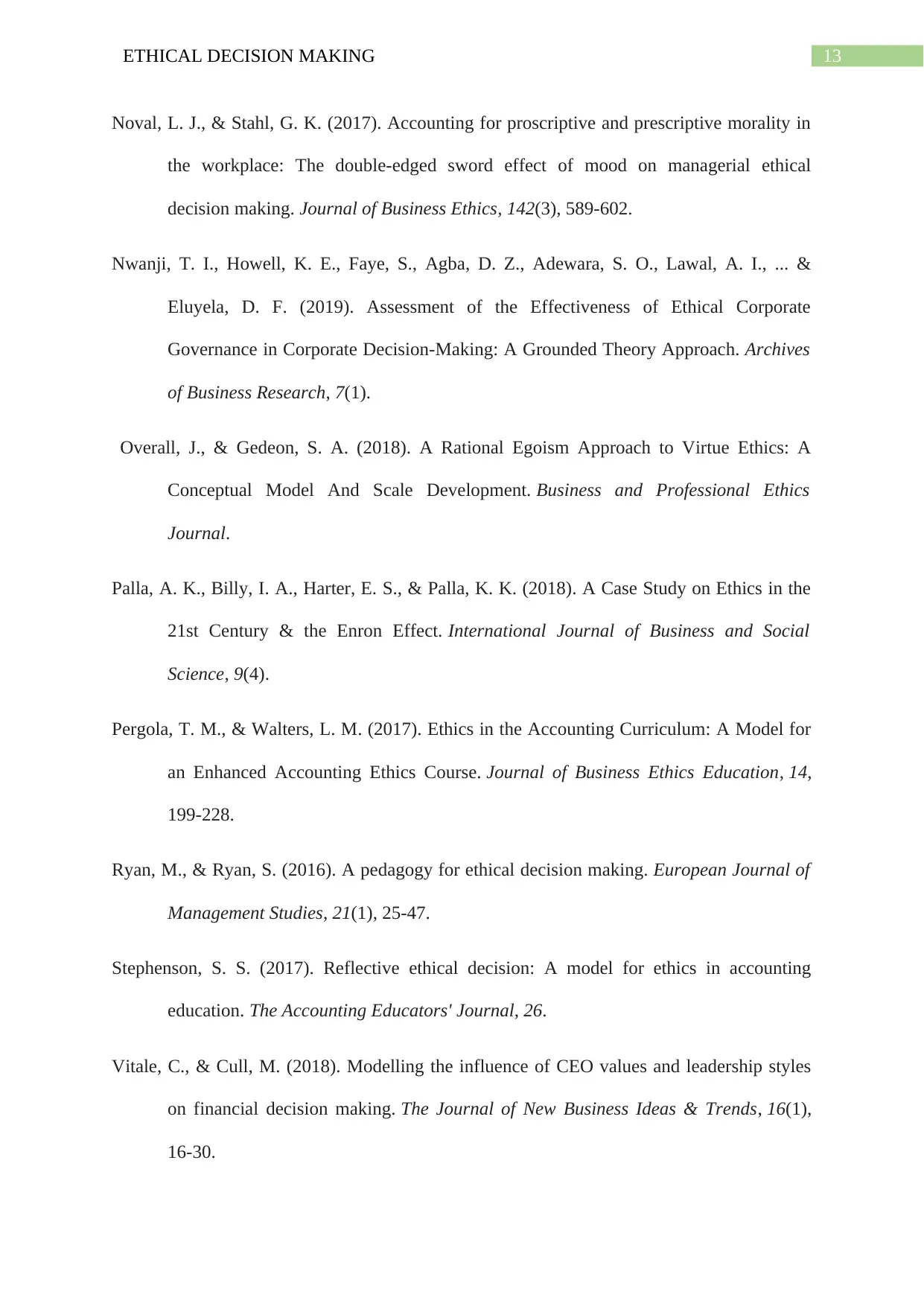
13ETHICAL DECISION MAKING
Noval, L. J., & Stahl, G. K. (2017). Accounting for proscriptive and prescriptive morality in
the workplace: The double-edged sword effect of mood on managerial ethical
decision making. Journal of Business Ethics, 142(3), 589-602.
Nwanji, T. I., Howell, K. E., Faye, S., Agba, D. Z., Adewara, S. O., Lawal, A. I., ... &
Eluyela, D. F. (2019). Assessment of the Effectiveness of Ethical Corporate
Governance in Corporate Decision-Making: A Grounded Theory Approach. Archives
of Business Research, 7(1).
Overall, J., & Gedeon, S. A. (2018). A Rational Egoism Approach to Virtue Ethics: A
Conceptual Model And Scale Development. Business and Professional Ethics
Journal.
Palla, A. K., Billy, I. A., Harter, E. S., & Palla, K. K. (2018). A Case Study on Ethics in the
21st Century & the Enron Effect. International Journal of Business and Social
Science, 9(4).
Pergola, T. M., & Walters, L. M. (2017). Ethics in the Accounting Curriculum: A Model for
an Enhanced Accounting Ethics Course. Journal of Business Ethics Education, 14,
199-228.
Ryan, M., & Ryan, S. (2016). A pedagogy for ethical decision making. European Journal of
Management Studies, 21(1), 25-47.
Stephenson, S. S. (2017). Reflective ethical decision: A model for ethics in accounting
education. The Accounting Educators' Journal, 26.
Vitale, C., & Cull, M. (2018). Modelling the influence of CEO values and leadership styles
on financial decision making. The Journal of New Business Ideas & Trends, 16(1),
16-30.
Noval, L. J., & Stahl, G. K. (2017). Accounting for proscriptive and prescriptive morality in
the workplace: The double-edged sword effect of mood on managerial ethical
decision making. Journal of Business Ethics, 142(3), 589-602.
Nwanji, T. I., Howell, K. E., Faye, S., Agba, D. Z., Adewara, S. O., Lawal, A. I., ... &
Eluyela, D. F. (2019). Assessment of the Effectiveness of Ethical Corporate
Governance in Corporate Decision-Making: A Grounded Theory Approach. Archives
of Business Research, 7(1).
Overall, J., & Gedeon, S. A. (2018). A Rational Egoism Approach to Virtue Ethics: A
Conceptual Model And Scale Development. Business and Professional Ethics
Journal.
Palla, A. K., Billy, I. A., Harter, E. S., & Palla, K. K. (2018). A Case Study on Ethics in the
21st Century & the Enron Effect. International Journal of Business and Social
Science, 9(4).
Pergola, T. M., & Walters, L. M. (2017). Ethics in the Accounting Curriculum: A Model for
an Enhanced Accounting Ethics Course. Journal of Business Ethics Education, 14,
199-228.
Ryan, M., & Ryan, S. (2016). A pedagogy for ethical decision making. European Journal of
Management Studies, 21(1), 25-47.
Stephenson, S. S. (2017). Reflective ethical decision: A model for ethics in accounting
education. The Accounting Educators' Journal, 26.
Vitale, C., & Cull, M. (2018). Modelling the influence of CEO values and leadership styles
on financial decision making. The Journal of New Business Ideas & Trends, 16(1),
16-30.
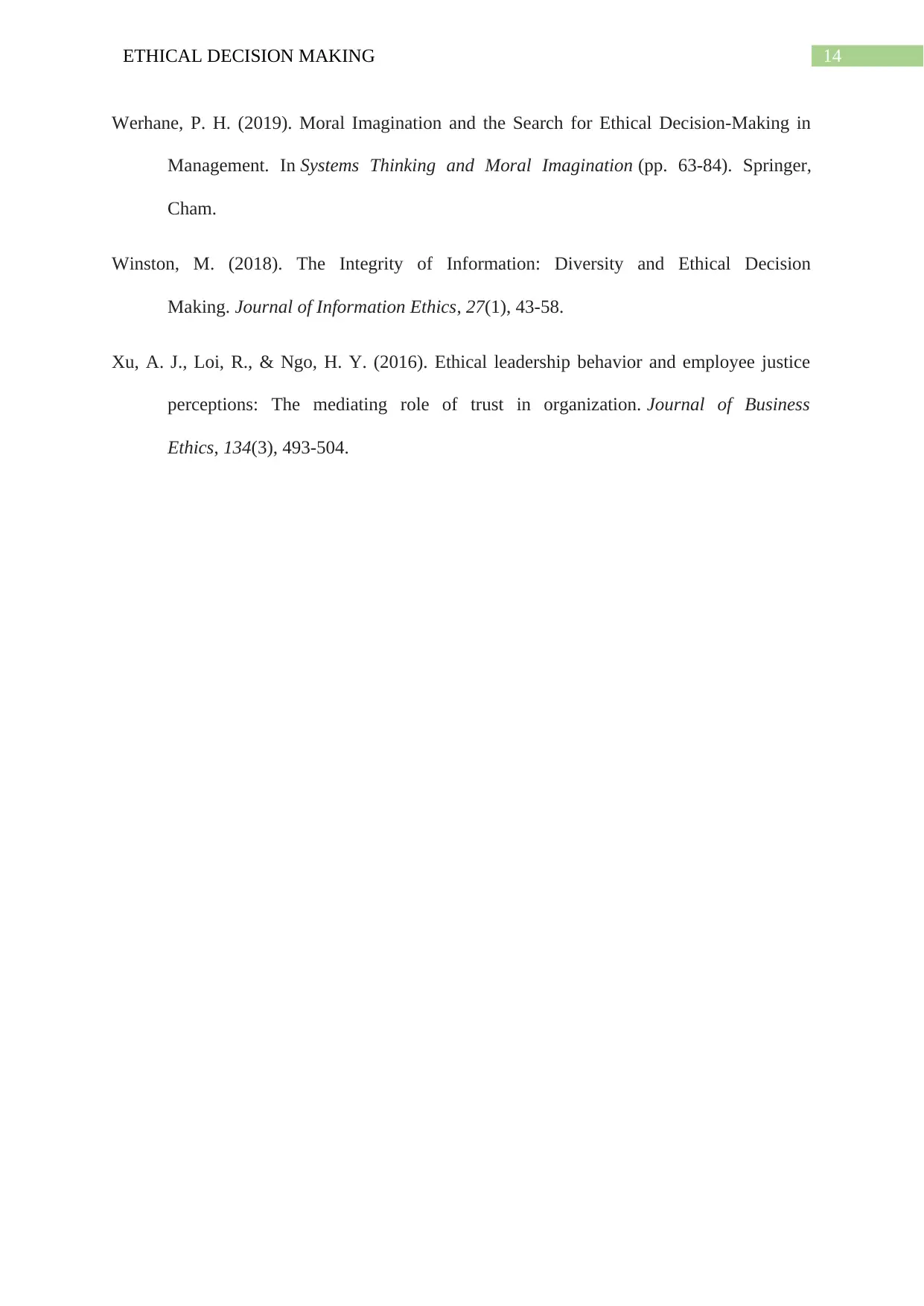
14ETHICAL DECISION MAKING
Werhane, P. H. (2019). Moral Imagination and the Search for Ethical Decision-Making in
Management. In Systems Thinking and Moral Imagination (pp. 63-84). Springer,
Cham.
Winston, M. (2018). The Integrity of Information: Diversity and Ethical Decision
Making. Journal of Information Ethics, 27(1), 43-58.
Xu, A. J., Loi, R., & Ngo, H. Y. (2016). Ethical leadership behavior and employee justice
perceptions: The mediating role of trust in organization. Journal of Business
Ethics, 134(3), 493-504.
Werhane, P. H. (2019). Moral Imagination and the Search for Ethical Decision-Making in
Management. In Systems Thinking and Moral Imagination (pp. 63-84). Springer,
Cham.
Winston, M. (2018). The Integrity of Information: Diversity and Ethical Decision
Making. Journal of Information Ethics, 27(1), 43-58.
Xu, A. J., Loi, R., & Ngo, H. Y. (2016). Ethical leadership behavior and employee justice
perceptions: The mediating role of trust in organization. Journal of Business
Ethics, 134(3), 493-504.
1 out of 15
Related Documents
Your All-in-One AI-Powered Toolkit for Academic Success.
+13062052269
info@desklib.com
Available 24*7 on WhatsApp / Email
![[object Object]](/_next/static/media/star-bottom.7253800d.svg)
Unlock your academic potential
© 2024 | Zucol Services PVT LTD | All rights reserved.





